Ururangi Atmospheric conditions, winds, and the sky
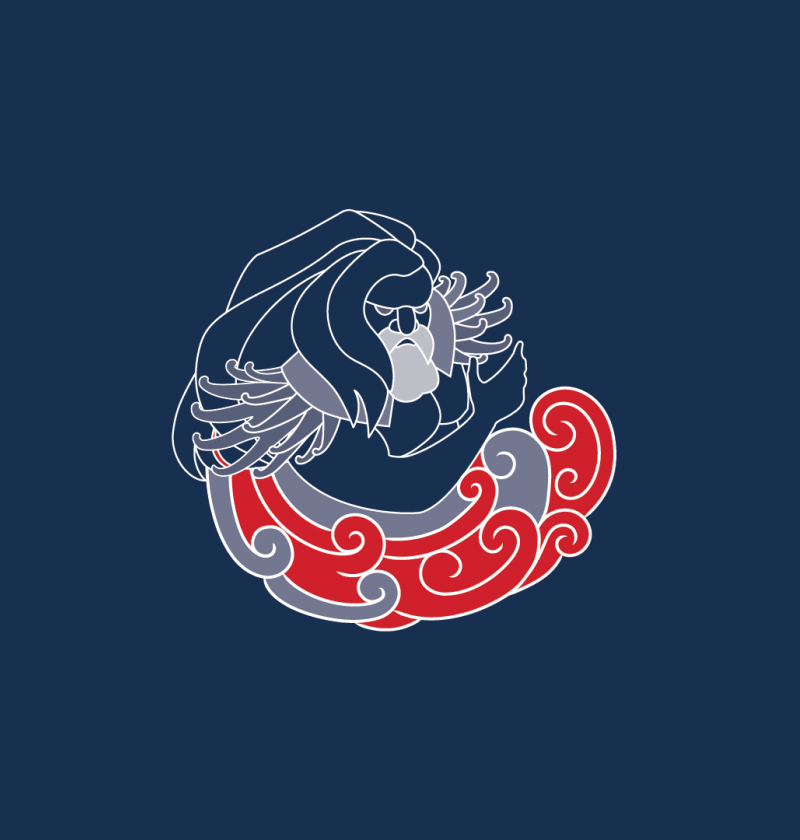
E tū Ururangi e
Tukua mai he hau kōtengitengi
Tukua mai he hau pūrekereke
He hau hei miri i te kiri
Behold Ururangi
Send a gentle breeze
Send a puff of wind
A wind to caress my skin
Ururangi (Merope) is the star linked to atmospheric conditions, winds, and the sky. Ururangi means ‘winds of the sky’, and is associated with the various types of winds and the weather patterns each brings. Ururangi resides in the domain of Tāwhirimātea, the atua of the winds and weather.
Our interactions with Ururangi can be seen in the quality of the air we breathe, the visibility of the night sky, and the winds that are used to fill the sails of our navigating ancestors and those who continue the practice of navigating the oceans. The wind can also be destructive.
“We connect with Ururangi whenever we feel the winds connect to our bodies and the swaying of the trees. There are 500 distinct types of winds with different personalities and names. For example, te hau māngere is the lazy wind. Te haututū is the mischief wind which can also be referred to our children who are called haututū, mischievous but curious personalities” (Rereata Makiha, pers. comm., 2019).
The winds and atmosphere have life force (mauri), and our interactions with them affect our own mauri (see the Matariki section for the definition of mauri used in this report). They are a matangaro, an invisible phenomenon – we can detect them by the interactions they have with Earth, the sea, people, landscapes, ecosystems, and living beings (Rereata Makiha, pers. comm., 2021).
Observations of the sky have informed specific tikanga Māori (customs/protocols) and are essential for readings of Matariki, which provides predictions for the year ahead. The changing of the seasons is tracked through observing the appearance of certain stars and the changing path of the sun (Harris et al, 2013).
The maramataka (see Tupuānuku section) provides a framework for understanding the environment (te taiao) and informing cultural practices. The practice of observing particular signs (tohu) adds to and tests knowledge of the environment, and allows that knowledge to be shared and passed down through the generations (Hikuroa, 2017).
Being able to follow the maramataka and observe Matariki and other celestial tohu is reliant on sky visibility to optimise times for harvesting, planting, and growing food. The maramataka helps determine when to plant or harvest crops, and the appropriate times to hunt and fish for specific animals (Harris et al, 2013). Observing the maramataka is also crucial to preserving tikanga and cultural knowledge. Practices such as karakia (incantations), pūrākau (stories), and waiata (song) are often used in conjunction with planting and harvesting, and these are lost if tohu are not seen or practices decline (Smith, 2011; Tawhai, 2013).
Ururangi and observation of the winds and skies also provides linkages to the first peoples who arrived in Aotearoa. Navigation of the waka hourua (double hulled waka used for ocean migration), used to travel across the Pacific utilises wayfinding. The stars, moon, sun, wind, and birds, are used for navigation (Science Learning Hub, 2014). The path of the sun and the rising and setting of specific stars during a journey are used to steer the waka in the right direction. These locations shift over the course of a long voyage, so accurate understanding and observations are crucial to navigation (Harris et al, 2013).
The links to first peoples, such as Kupe, Māui, and Rata, and their achievements in relation to waka hourua connect many Māori to their ancestral practices and tūpuna (ancestors). Storytelling, songs, and poetry are used to remember the names of navigators, captains, canoes, and crew (Barclay-Kerr, 2016). These practices continue to be upheld today. Along with learning traditional navigational knowledge, participants are able to see the importance of their connection to the environment and the issues affecting the Pacific Ocean (Barclay-Kerr, 2016).
Connecting with the night sky is a universal human experience. People often have an emotional and spiritual attachment to observing the stars, and studies have found it has psychological benefits including improved mood and enhanced social connections (Blair, 2018; Kelly, 2003; Kelly & Daughtry, 2007; Kelly & Kelly, 2010). People who are constantly exposed to pristine night skies also report an increased sense of responsibility towards nature (Blair, 2018).
The Southern Cross constellation (Te Pae Māhutonga) is a distinctive feature of the night sky in Aotearoa, visible at any time of year. It is one of the first star patterns children learn to recognise and is associated with national and cultural identity. As well as appearing on our flag, the Southern Cross is part of several national memorials such as the Tomb of the Unknown Warrior. Planes, boats, newspapers, organisations, and companies have been named after the Southern Cross, including the first plane to cross the Tasman Sea in 1928, highlighting its importance as a national symbol (Wassilieff, 2006).
While the winds and atmosphere are invisible, their impacts can be seen in many different aspects of our lives. Good air quality allows us to live healthy, active lives, and many recreational, cultural, educational, and economic activities are directly related to the winds and the sky (Auckland University of Technology, nd; Tainio et al, 2021; UNESCO, nd).
Universities, observatories, and research institutions in Aotearoa conduct world-leading research in astronomy. This creates many scientific and educational opportunities, and through building international space agency partnerships inspires new generations of researchers.
An important aspect of this is the development of Māori astronomical research at our universities, building knowledge of the sky as a cultural resource. Māori-led and Māori-focused astronomical research is growing. More than just recording the historical practices of Māori, the research focuses on giving new life and purpose to the historical practices of Māori and revitalising various Māori practises and beliefs (Whaanga & Matamua, 2016).
The MacKenzie Basin has been designated an international dark sky reserve, the largest in the southern hemisphere and one of only eight globally. As well as enabling astronomical research, the reserve is a tourism drawcard. It has a layered design approach, where the natural, cultural, scientific, and astronomical heritage values of the site are interwoven (UNESCO, nd).
Ongoing connections to Māori astronomical practices can be seen more widely in the increasing celebrations of Matariki in recent years. Schools, communities, and marae around the country hold activities linked to Matariki, and from 2022 Matariki has been adopted as a national public holiday. Matariki traditions reflect the strong connection many Māori have with their surrounding environment, and how important the environment was for the survival of Māori. While our relationship to the world may have changed in a modern context, Matariki reminds us of the link between humanity and the environment that will always remain (Whaanga & Matamua, 2016).
Matariki celebrations connect us to the winds as well as the stars. Today many kite festivals happen around the country during Matariki. Often these are co-led by iwi groups and local councils. An example is the Ōrākei Manu Aute Kite Day, a community celebration of kite-flying organised by Auckland Council and Ngāti Whātua Ōrākei (Matariki Festival, nd).
Aotearoa has a strong connection to the winds through sailing. Sailing is a popular recreational activity, with around 125,000 New Zealanders taking part in sailing or windsurfing in 2020 (Dodd et al, 2020). It is also a strong source of national pride, with great success in many international events, including Olympic Games and the America’s Cup. Along with this, sailing contributes to the economy through events such as the America’s Cup (MBIE, 2017).
Wind power is an increasingly important part of energy generation in Aotearoa, making up around 5 percent of our electricity supply. Current wind generation capacity is 690 megawatts, with a goal of increasing this to 2,500 megawatts by 2030 and 8,000 megawatts by 2060 (MBIE, 2020b).
The state of Ururangi can be observed through measuring the conditions of the air, the sky, and the wind.
Our activities affect the quality of the air we breathe. Air quality is measured through the levels of particulate matter (PM10 and PM2.5) and the concentration of four gases – nitrogen dioxide (NO2), sulphur dioxide (SO2), carbon monoxide (CO), and ground-level ozone (O3).
Major sources for air pollutants include vehicle emissions (PM2.5, NO2, and CO), manufacturing and industry (PM2.5), wood burning for home heating (PM2.5), and dust from unsealed roads (PM10).
In general terms, air quality is slowly improving at a majority of measurement sites in Aotearoa, although pollution levels are greater than the World Health Organization guidelines for most air pollutants some of the time (WHO, 2021) (see figure 8 for details for PM10; see indicator for trend assessment detail). For more detail, see Our air 2021. (See indicators: PM₁₀ concentrations, PM₂.₅ concentrations, Sulphur dioxide concentrations, Nitrogen dioxide concentrations, Carbon monoxide concentrations, Ground-level ozone concentrations.)
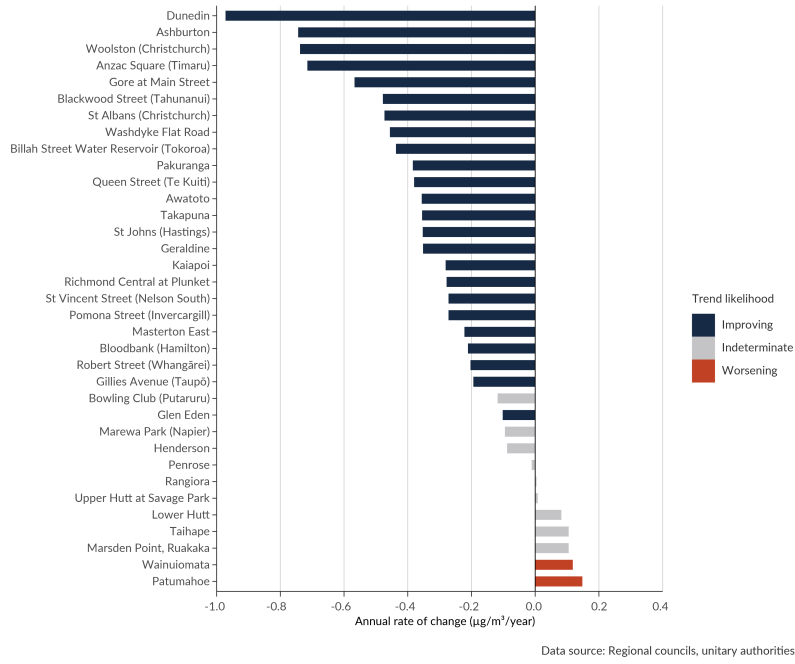
Image: Data source — Regional councils, unitary authorities
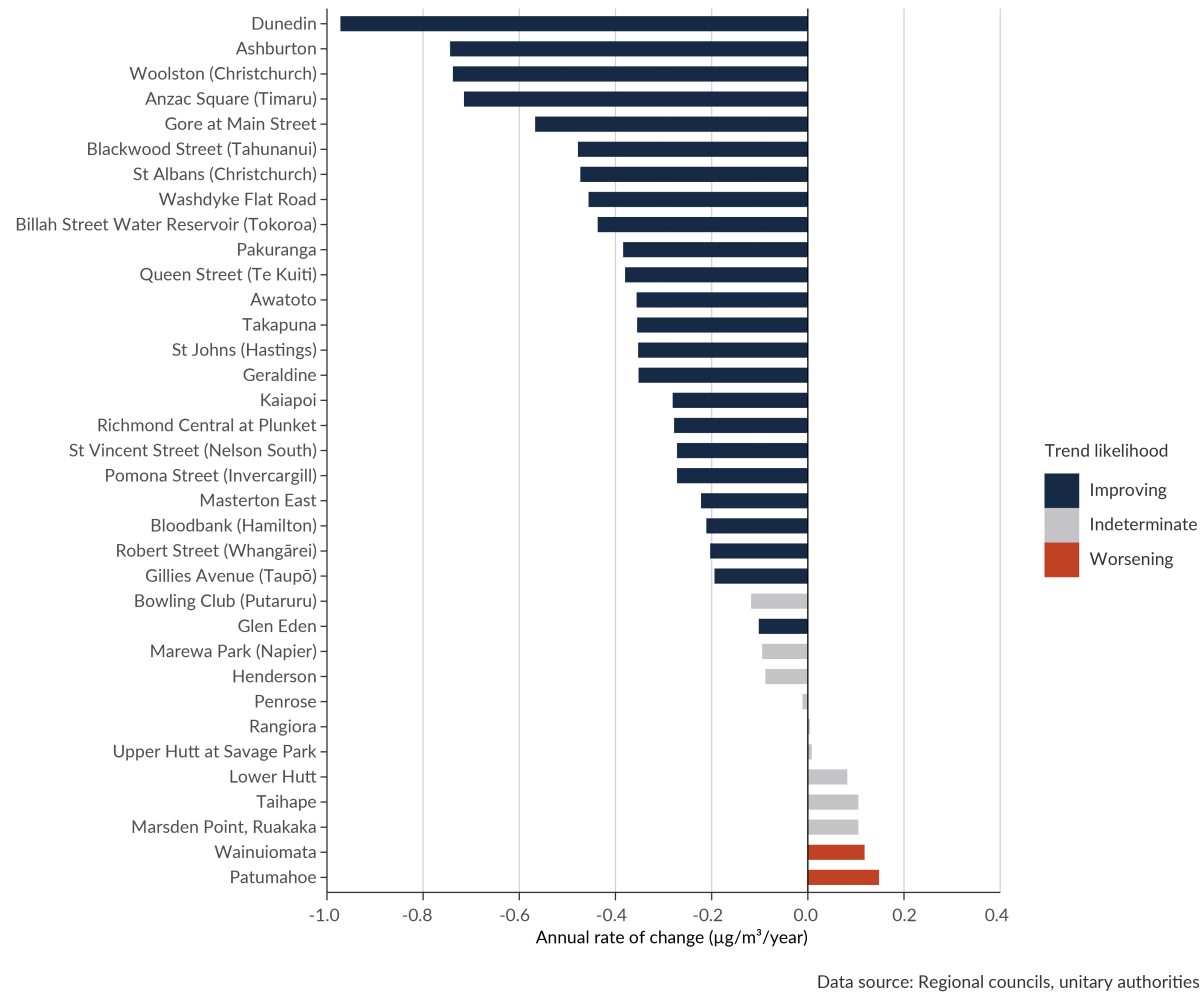
Image: Data source — Regional councils, unitary authorities
Despite the winds and atmosphere being invisible to the eye (matangaro), if the air is not healthy – if its mauri can be regarded to be in a poor state – this has major impacts on human health (see Matariki section for the definition of mauri used in this report).
In 2021, the World Health Organization lowered the safe exposure levels for most air pollutants in its guidelines, reflecting recent research which found that air pollution negatively affects human health even at very low concentrations (WHO, 2021).
Air pollution causes serious health effects, including premature deaths, heart and lung disease, and respiratory diseases (Huangfu & Atkinson, 2020; Lee et al, 2020; Orellano et al, 2020, 2021; Zheng et al, 2021). Modelling indicated that human-generated PM10 was linked to 27 premature deaths per 100,000 adults over 30 in 2016. More detail is available in Our air 2021. (See indicator: Health impacts of PM₁₀.)
Between 2000 and 2019, hospitalisation rates for respiratory diseases have risen in Aotearoa. In 2017, the economic cost of respiratory disease (from all causes) was estimated at $6.7 billion per year. There are significant inequalities in respiratory health outcomes: in 2019, hospitalisation rates for Pacific peoples and for Māori were higher than average (2.6 and 2.2 times respectively), and hospitalisation rates in the most deprived households were 2.3 times higher than average (Barnard & Zhang, 2021).
Studies have found that restrictions associated with the COVID-19 pandemic in 2020 improved air quality and reduced respiratory disease rates in Aotearoa (Barnard & Zhang, 2021; Talbot et al, 2021b). The first COVID-19 lockdown (March to June 2020) resulted in a significant and sudden change to our lifestyles. Most car trips were not allowed during the most restrictive lockdown periods, leading to a large and immediate reduction in NO2 in urban areas – between 38 percent and 66 percent below the long-term mean, adjusted for weather. In most places these levels rebounded to near pre-lockdown levels as restrictions eased and motor vehicle use increased again. This shows how much our behaviours affect the world around us, and how quickly we can see changes in the environment when we shift the way we live (Talbot et al, 2021a).
Changes to the places we live can also affect the health of Ururangi. Urban greenspaces have many benefits for the physical and mental wellbeing of people (see Tupuārangi section). Research has found that urban tree cover reduces NO2 concentrations in the air and can result in fewer respiratory problems among residents (Rao et al, 2014).
Allergic rhinitis or hay fever is another common respiratory condition, affecting about 20 percent of people in Aotearoa, although this number has been increasing. Hay fever is commonly caused by an allergic reaction to wind-borne pollen. Environmental changes such as the spread of new invasive plants, land-use changes, and climate change have likely contributed to its increase (Newnham, 2022).
There are significant data gaps in our understanding of airborne pollen in Aotearoa, with very little reporting and forecasting compared to other countries. The last systematic nationwide study of airborne pollen was conducted in 1989. More accurate pollen monitoring and forecasting could help those with hay fever to better manage it and reduce the severity of impacts (Newnham, 2022).
The state of Ururangi can be measured by our ability to see the night sky. In data from 2014, 74 percent of the North Island and 93 percent of the South Island had night skies that were either pristine or degraded only near the horizon (see figure 9). Due to light pollution being concentrated in urban centres, an estimated 56 percent of the Aotearoa population live in areas where the Milky Way is not visible due to artificial brightness. (See indicator: Artificial night sky brightness.)
Not being able to see the night sky has negative impacts. As discussed earlier, being able to see the night sky has positive impacts on wellbeing. With 84 percent of the population of Aotearoa living in urban areas in 2019 (Stats NZ, 2021b), opportunities to see the sky in its fullness are significantly reduced. For some Māori, not being able to clearly see the night sky has implications for cultural connections and tikanga. Reading Matariki, observing tohu, traditional food gathering practices (gathering mahinga kai), and navigating by the stars are more difficult or impossible when the sky is not visible. The more general wellbeing effects that come from connecting with the night skies are also made more difficult with light pollution in urban areas.
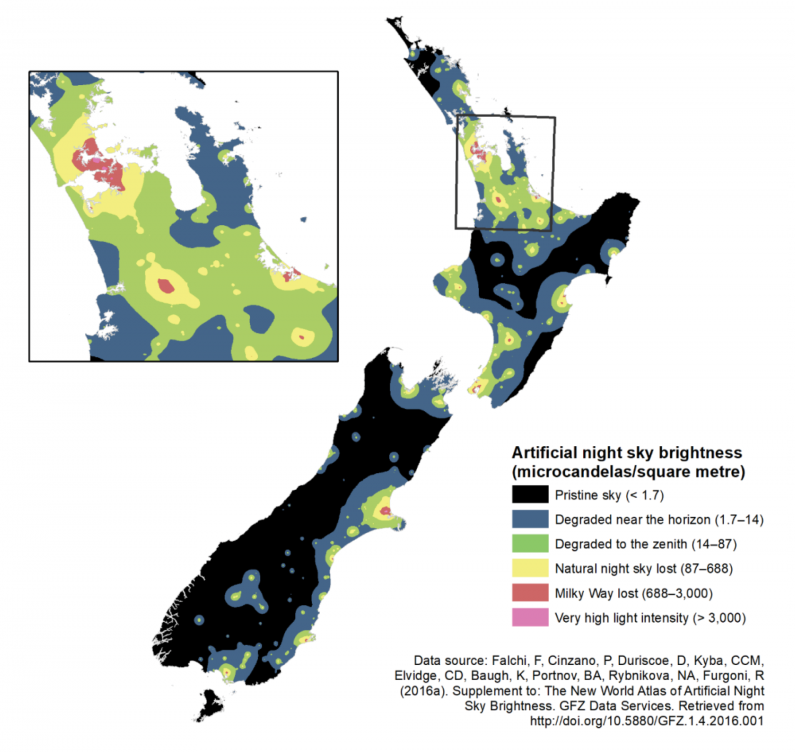
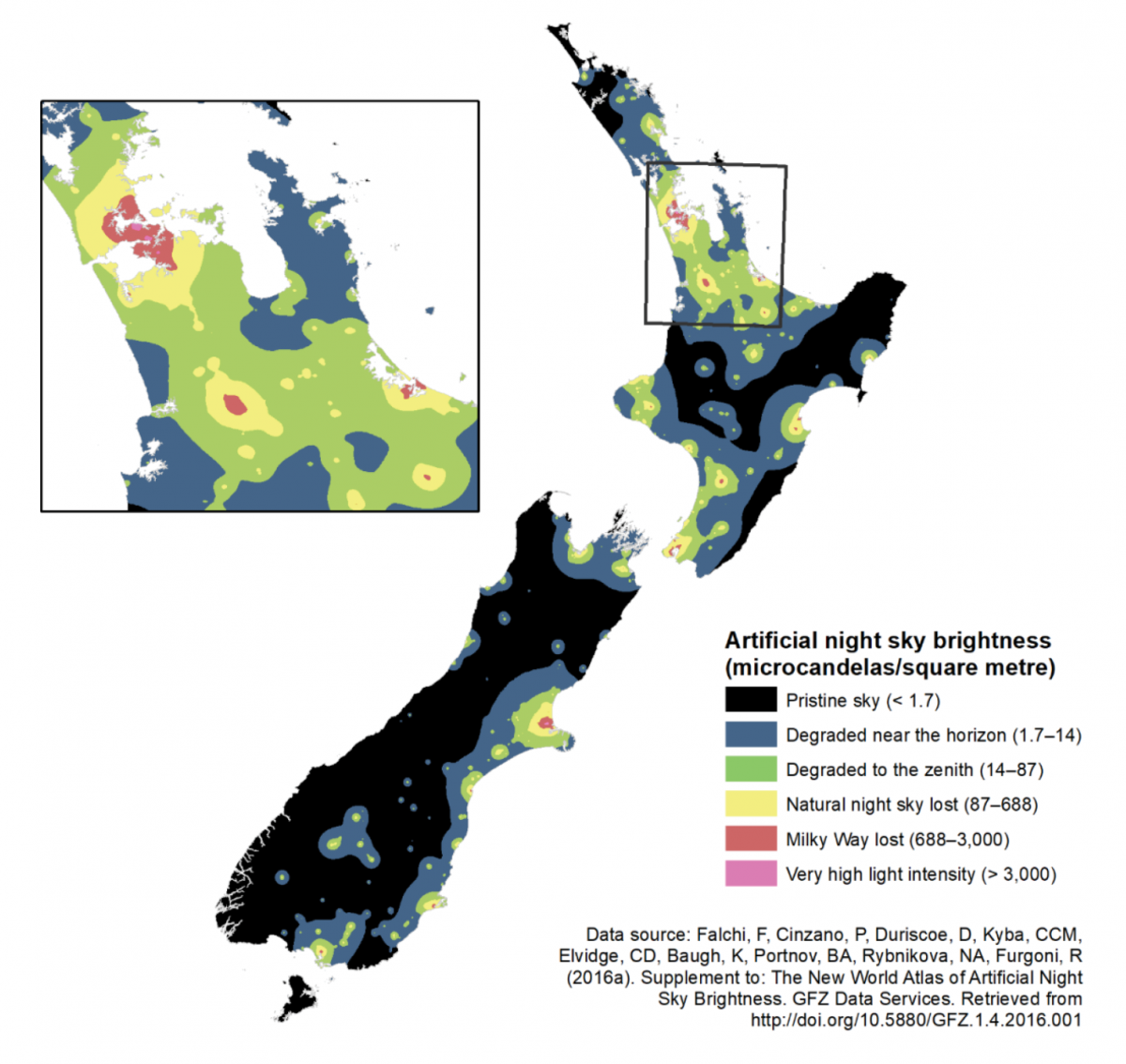
There is evidence that the increasing use of energy-efficient LED lights in urban areas is increasing light pollution. These blue-rich LED lights disrupt the circadian day-and-night rhythms of living organisms and have potential negative effects for humans, species, and whole ecosystems (Schulte-Römer et al, 2019). Light pollution affects many species, disrupting navigation and orientation, foraging activity, reproduction, communication, and community composition.
Measurements in Auckland city recorded night sky brightness 10 times higher than natural levels, which can partially mask even the moon (McNaughton et al, 2022). This has a particular impact on insects, with artificial light disrupting natural behaviours and contributing to the global decline in insect numbers (Owens et al, 2020). Studies of wētā have found they alter their behaviour near light sources, and that light significantly reduced the number of observations of both cave and tree wētā (Farnworth et al, 2018).
Local knowledge developed by some iwi informs understanding of provincial weather and climate conditions. A range of tohu are used in preparation for activities that are sensitive to changes in weather and climate. For Ngāi Tahu, the nor’west arch (Te Māuru) is core to understanding weather patterns in the South Island. The height of the arch above the Southern Alps (Kā Tiritiri-o-te-Moana) during a warm nor’wester helps inform the intensity of the cold southerly (Skipper, 2018).
Exposed coastal locations in Aotearoa often experience strong winds due to being positioned in the direction of prevailing westerly winds (Macara, 2018). The indicator for extreme wind measures the daily maximum wind gust (a measure of windiness), annual maximum wind gust (a measure of wind strength), and the number of days where gusts were extreme for that location (potentially damaging). Fourteen sites around the country had sufficient data between 1980 and 2019 to allow trends in extreme wind to be determined. Two of the extreme wind measures likely or very likely decreased at 12 of the 14 measurement sites (daily maximum wind gust and number of days with a gust that is extreme for that location). The annual maximum wind gust likely or very likely decreased at 11 sites (see indicator for trend assessment detail). Only Gisborne and New Plymouth showed an increase across all three measures. (See indicator: Extreme wind.)
The recent declines in extreme wind magnitude and frequency may be related to the Southern Annular Mode (SAM) more often being in a positive phase which moves storm tracks further south, though the size of this effect is uncertain (NIWA, nd). For more details on the SAM and its impacts on Aotearoa, see Our atmosphere and climate 2020. Climate models project that extreme wind will increase in the southern North Island and the South Island, especially east of the Southern Alps, in the coming years. (See indicator: Extreme wind.)
Extreme wind can cause significant harm to people and infrastructure. Natural disasters, such as the 2021 tornado which affected South Auckland in June of the same year, can cause fatalities, injuries, and harm to mental health (Insurance Council of New Zealand, 2021; Makwana, 2019). In February 2022 ex-cyclone Dovi caused treefall, power outages, road closures (including the Auckland Harbour Bridge), slips, flight and ferry cancelations, and damage to farming infrastructure and crops (RNZ, 2022a, 2022b). See Waipunarangi section for more on the impacts of natural disasters on mental wellbeing.
Economic impacts of extreme winds to infrastructure, forestry, and agriculture can also be high. A windstorm in the South Island in September 2021 caused an estimated $20 million in damage, with the South Auckland tornado resulting in $32 million in insurance claims (Insurance Council of New Zealand, 2021). Wind damage was responsible for 60,000 hectares of damage in planted forests between 1945 and 2010, a median of 90 hectares per extreme wind event (Moore et al, 2013). Strong winds can also increase the risk and spread of fire (Scion, 2015).
International air quality guidance has changed with the World Health Organization 2021 guideline update. Air quality in Aotearoa is improving slowly at a majority of measurement sites, but in many places pollution levels are above the new guidelines. Light pollution is concentrated around our cities, where most people live. Interacting with our pristine night skies requires visiting dark sky reserves or travelling away from urban centres. The damage human activity is causing to the air, winds, and sky has a range of negative consequences. While they do not touch us physically, changes to atmospheric conditions have an impact on many aspects of our wellbeing, including health and recreation.

Ururangi Atmospheric conditions, winds, and the sky
April 2022
© Ministry for the Environment